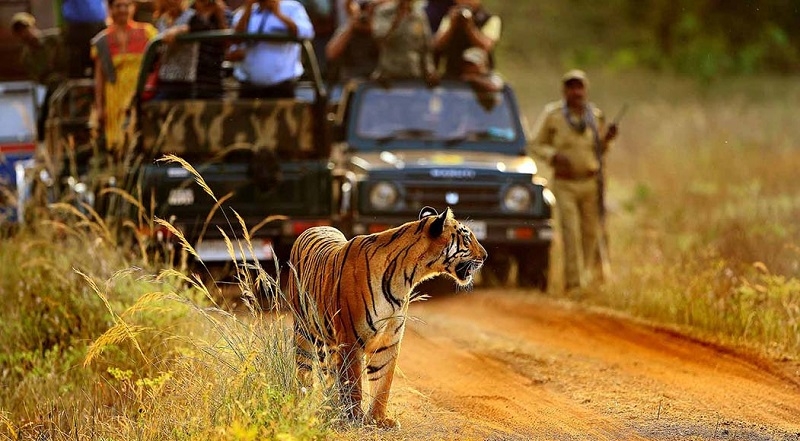CAG raps Forest Deptt over laxity in management of tiger reserves
| Date :04-Jul-2019 |

Staff Reporter:
Recommends various measures including speedy relocation of project-affected persons, unified control of tiger reserves, installing GPS in tourist vehicles to regulate tourism
In its latest report on Economic Sector, Comptroller and Auditor General (CAG) has pulled up Forest Department for ‘deficiencies’ in planning for conservation and protection of tigers, protection and conservation, allocation of resources, human resource management, support infrastructure, tourism in tiger reserves, and overall management of tiger reserves in Maharashtra. CAG has made several observations after field visits and examining the records for six tiger reserves namely Bor, Melghat, Navegaon-Nagzira, Pench, Tadoba-Andhari, and Sahyadri. Of these six, barring Sahyadri, all are in Vidarbha region. The six tiger reserves are spread over five National Parks and 14 Wildlife Sanctuaries encompassing an area of 9,116.80 sq km consisting of 3,951.02 sq km of core area and 5,165.78 sq km of buffer area.
CAG conducted performance audit on Management of Tiger Reserves in Maharashtra for the period 2012-18. The audit indicated that apex level interventions for enabling policy decisions and for taking major initiatives regarding protection and conservation of tigers were ‘ineffective’. Besides, the Tiger Conservation Plans that play a significant role in formulating management strategy for 10 years were ‘non-existent’ in Bor and Navegaon-Nagzira tiger reserves while in remaining four tiger reserves, the plans were formulated ‘with delays ranging from two-and-a-half to seven years’. Also, the department neither placed these plans in the public domain nor made those available in local languages, as required. An important part of tiger reserve management is maintaining the compartment history.
The compartment history includes details of compartment boundary, stream and riparian system, roads, perennial pools, reservoirs, lakes, groove of old large trees, villages, agriculture land, operations performed etc. It serves as an important document for deciding plan and strategies of management. Range Forest Officer is required to update compartment history on annual basis, and it is vetted by senior officers up to Division level. However, CAG observed that these were ‘not being maintained in any of the tiger reserves’. Further, CAG has rapped the department for ‘not showing’ the resolve to secure inviolate space available for tiger habitats and that these ‘were being curtailed due to encroachment by human settlements and tourist facilities’.
These were further fragmented and criss-crossed by highways and railway lines and this led to tiger deaths due to electrocution and road accidents, it added in the report. The support infrastructure critical for protection of tiger habitats ‘were inadequate’, CAG has observed. Further, it has described ‘unregulated tourism’ particularly in Tadoba Andhari Tiger Reserve as ‘a major cause for concern’. As per the report, the draft notification of Eco-Sensitive Zone (ESZ) issued in the year 2015 mentioned that no new commercial hotels and resorts would be permitted within one km of the boundary of the protected areas except for accommodation for temporary occupation of tourists related to eco-friendly tourism activities.
However, CAG observed, ‘fifteen resorts/home-stays, however, had come up within one kilometer of the core boundary after 2015. Further, 16 home-stays/resorts were developed prior to 2013 near the core boundary of TATR without obtaining permission from the competent authorities’. Commenting on tourism in tiger reserves, CAG stated that despite the norm of allowing 122 vehicles per day, the said norm was ‘exceeded on 93 occasions’ during 2012-17 and the excess ranged between two and 51 vehicles per day! National Tiger Conservation Authority (NTCA) guidelines prescribe that water-holes and cement troughs should not be constructed near tourist routes and that the visitors should keep a minimum distance of over 20 meters from all wildlife and cordoning, luring, or feeding of any wildlife is prohibited. The joint verification by CAG team and Forest Department revealed that water-holes at Tadoba-Andhari, Navegaon-Nagzira, and Pench tiger reserves were ‘located close to the tourist route’. Also, the visitors ‘did not maintain the prescribed distance’ during wildlife sighting. As per the provisions, State Government was to constitute a Steering Committee under the chairmanship of Chief Minister with Chief Wildlife Warden as Member Secretary. The said committee was to ensure co-ordination, monitoring, protection and conservation of tiger, co-predators and prey animals.
Though the committee was formed in August 2008 and reconstituted in February 2013, between 2012 and 2018 only one meeting of the committee was convened, that too, in January 2013. Against this backdrop, CAG has observed that the objective of formation of Steering Committee ‘was not met in the absence of regular meetings’. National Tiger Conservation Authority (NTCA) guidelines underlined need for safeguarding wildlife from high tension (HT) electric lines passing through tiger reserves. Ministry of Environment and Forests also issued guidelines in May 2014 to insulate transmission lines passing through national parks, wildlife sanctuaries, and wildlife corridors for preventing electrocution of animals. But, CAG found that HT lines with total length of 282.914 kms were passing through all the tiger reserves in Maharashtra. Between 2012.18, death of eight tigers due to electrocution was reported.